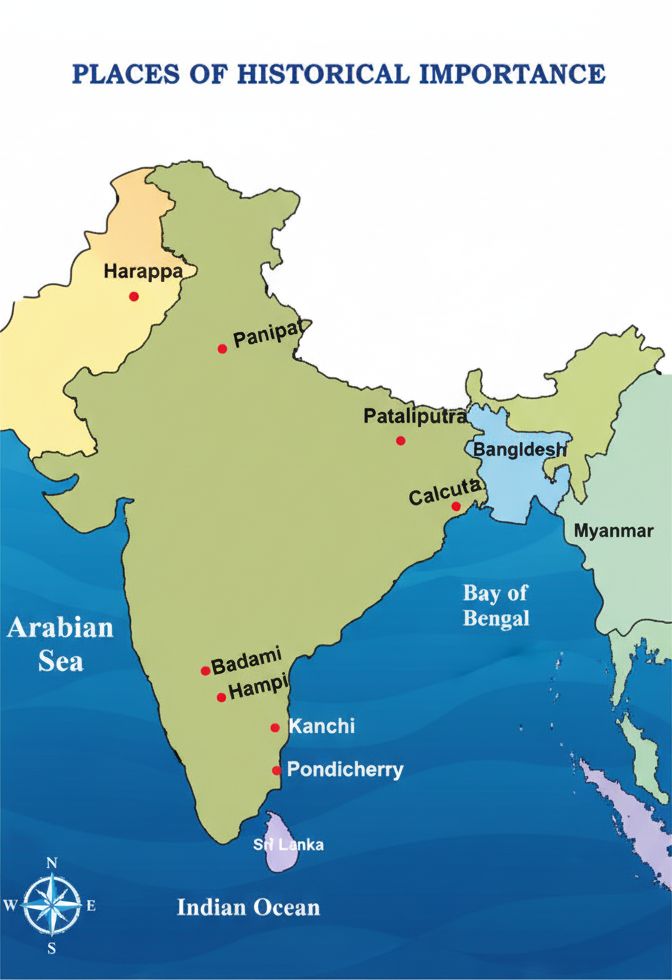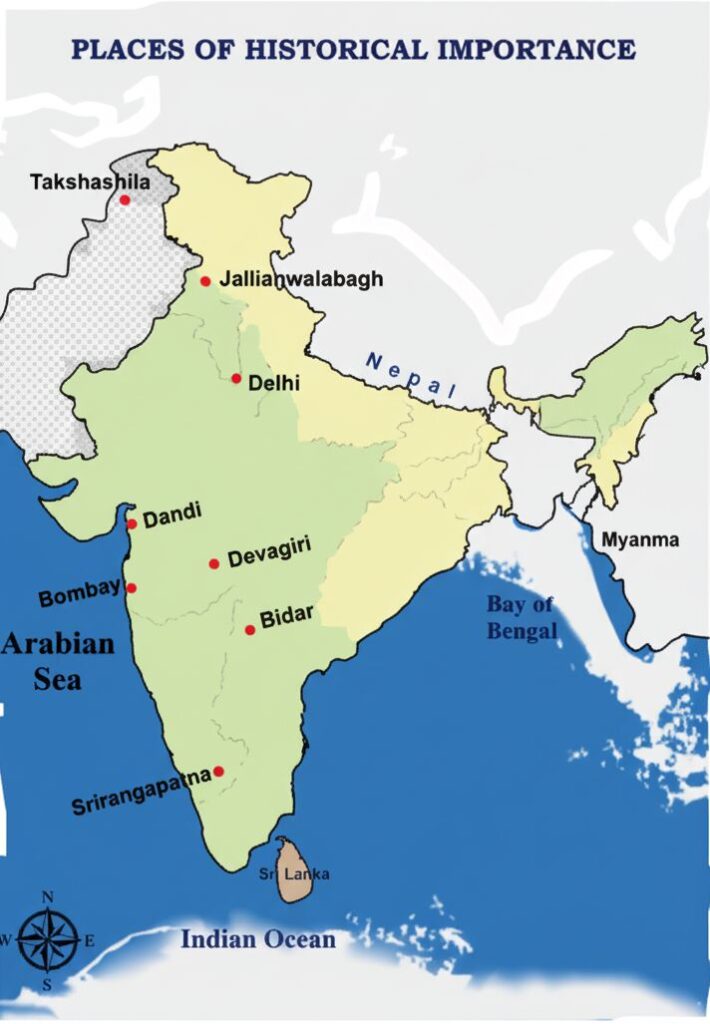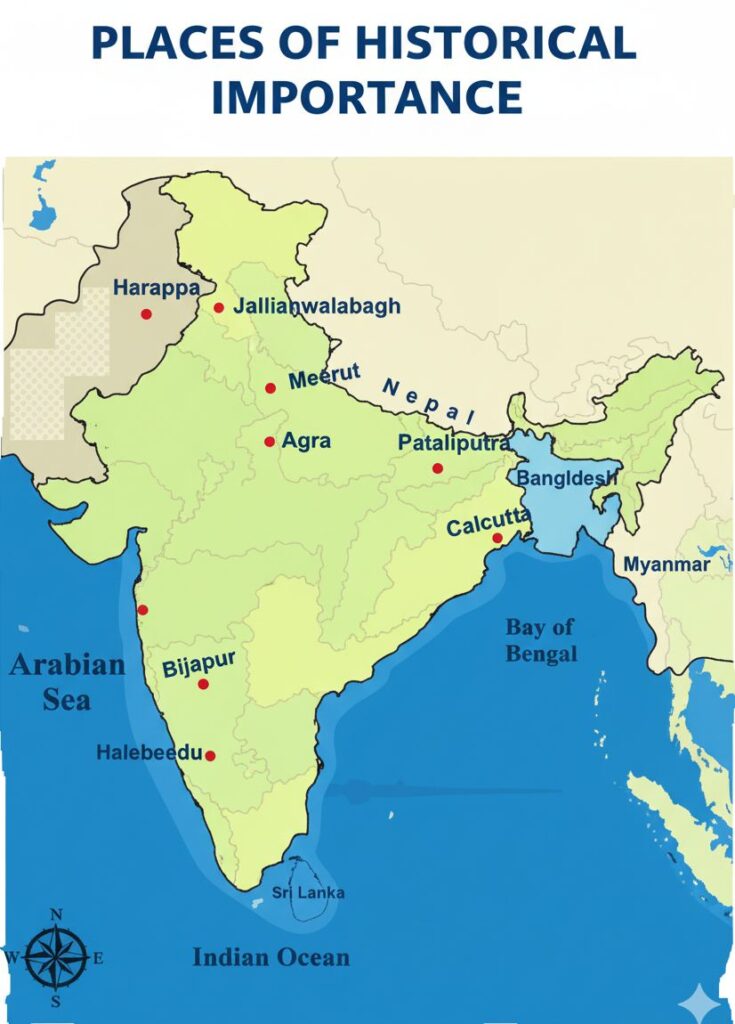2nd PUC History Question and Answer – MAP
Looking for 2nd PUC History textbook answers? You can download Chapter 8: MAP Questions and Answers PDF, Notes, and Summary here. 2nd PUC History solutions follow the Karnataka State Board Syllabus, making it easier for students to revise and score higher in exams.
Karnataka 2nd PUC History Textbook Answers—Reflections Chapter 8
MAP Questions and Answers, Notes, and Summary
2nd PUC History Chapter 8
Map
Scroll Down to Download Map PDF
Question 1.
Mark any Five of the following Historical places on the outline map of India, and add an explanatory note on each marked place in Two sentences.
- Harappa
- Pataliputra
- Panipat
- Calcutta
- Badami
- Hampi
- Pondicherry
- Kanchi
Answer:
- Harappa – It is one of the important sites of the Indus Valley Civilization, located in present-day Pakistan. The city was well-planned with streets, drainage systems, and granaries, showing advanced urban culture.
- Pataliputra – Situated on the banks of the river Ganga (present-day Patna), it was the capital of the Mauryan and Gupta Empires. It was a great center of administration, politics, and learning in ancient India.
- Panipat – Located in Haryana, Panipat was the site of three decisive battles in Indian history (1526, 1556, 1761). These battles changed the course of Indian politics and empire building.
- Calcutta – Now called Kolkata, it was the first capital of British India until 1911. It became a major center of trade, administration, and education during the colonial period.
- Badami – Located in Karnataka, it was the capital of the Chalukyas. The place is famous for its rock-cut cave temples and magnificent architecture.
- Hampi – Situated in Karnataka on the banks of the Tungabhadra River, it was the capital of the Vijayanagara Empire. It is renowned for its temples, palaces, and monuments, and is today a UNESCO World Heritage Site.
- Pondicherry – It was a French colonial settlement in India until 1954. The town is known for its unique blend of French and Indian culture.
- Kanchi (Kanchipuram) – Located in Tamil Nadu, it was a great center of learning and culture under the Pallavas and Cholas. It is famous for its temples and is considered one of the seven sacred cities of Hinduism.
Question 2.
Mark any five of the follow ing Historical Places on the outline map of India. And add an explanatory note on each marked place in two sentences.
- Takshashila
- Delhi
- Devagiri
- JailianWalabagh
- Dandi
- Bidar
- Srirangapatna
- Bombay
Answer:
- Takshashila – An ancient seat of learning located in present-day Pakistan. It attracted students from across Asia and was famous for its teachings in medicine, politics, and military science.
- Delhi – Delhi has been the capital of many dynasties including the Delhi Sultanate and the Mughals. It is rich in monuments like the Red Fort and Qutub Minar, reflecting its historical importance.
- Devagiri (Daulatabad) – Located in Maharashtra, it was the capital of the Yadavas and later shifted by Muhammad-bin-Tughlaq. The fort is known for its strong defenses and strategic position.
- Jallianwala Bagh – Situated in Amritsar, Punjab, it was the site of the tragic massacre of innocent people by General Dyer in 1919. This event shocked the nation and intensified the freedom struggle.
- Dandi – A coastal village in Gujarat where Mahatma Gandhi launched the famous Salt March in 1930. It became a symbol of non-violent resistance against British rule.
- Bidar – Located in Karnataka, it was an important city under the Bahmani and Barid Shahi rulers. It is famous for Bidriware handicrafts and its magnificent fort.
- Srirangapatna – Situated near Mysuru, it was the capital of Tipu Sultan. The Treaty of Srirangapatna (1792) and his heroic resistance against the British made it historically significant.
- Bombay (Mumbai) – It was an important port city given to the British by the Portuguese in 1661. Later it became a major center of trade, commerce, and the freedom movement.
Question 3.
Mark any Five of the following Historical places on the outline Map of India, and add an explanatory note on each marked place in two sentences.
- Agra
- Pataliputra
- Meerut
- Bijapur
- Halebeedu
- Harappa
- Jallianwa Uabagh
- Calcutta.
- Agra – Agra was the capital of the Mughal Empire under rulers like Akbar, Jahangir, and Shah Jahan. It is world-famous for the Taj Mahal, Agra Fort, and other Mughal monuments.
- Pataliputra – Present-day Patna, it was the capital of great empires like the Mauryas and Guptas. It was a hub of administration, culture, and education in ancient India.
- Meerut – Located in Uttar Pradesh, it was the place where the Revolt of 1857 first broke out. It holds a special place in Indian history as the beginning of the First War of Independence.
- Bijapur – Situated in Karnataka, it was the capital of the Adil Shahi dynasty. The city is famous for its Indo-Islamic monuments, especially the Gol Gumbaz.
- Halebeedu – Located in Karnataka, it was the capital of the Hoysala dynasty. The Hoysaleswara Temple at Halebeedu is renowned for its exquisite carvings and architecture.
- Harappa – An important site of the Indus Valley Civilization, located in present-day Pakistan. It shows evidence of a well-planned urban settlement with advanced drainage and granaries.
- Jallianwala Bagh – In Amritsar, Punjab, it was the site of the tragic massacre of innocent Indians by General Dyer in 1919. This brutal event marked a turning point in the freedom struggle.
- Calcutta – Now known as Kolkata, it was the capital of British India until 1911. It became a major political, cultural, and educational center during colonial times.



